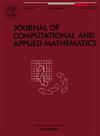具有热位移历史依赖性的摩尔-吉布森-汤普森型热弹性问题的数值分析
IF 2.1
2区 数学
Q1 MATHEMATICS, APPLIED
Journal of Computational and Applied Mathematics
Pub Date : 2024-10-16
DOI:10.1016/j.cam.2024.116317
引用次数: 0
摘要
在这项工作中,我们从数值角度研究了一个热传导模型,该模型由与历史相关的摩尔-吉布森-汤普森方程版本描述。首先,我们考虑了热问题,通过有限元法和隐式欧拉方案引入了完全离散的近似方法。我们证明了其解的离散稳定性,并提供了先验误差分析,从而在适当的正则条件下实现线性收敛。其次,我们讨论了热弹性情况的自然扩展。根据对热问题的分析,我们得出了类似的结果。最后,我们介绍了这两个问题的一些一维数值模拟,证明了近似的准确性以及离散能量和解的行为。本文章由计算机程序翻译,如有差异,请以英文原文为准。
Numerical analysis of a thermoelastic problem of Moore–Gibson–Thompson type with history dependence in the thermal displacement
In this work, we study, from the numerical point of view, a heat conduction model which is described by the history dependent version of the Moore–Gibson–Thompson equation. First, we consider the thermal problem, introducing a fully discrete approximation by means of the finite element method and the implicit Euler scheme. The discrete stability of its solution is proved, and an a priori error analysis is provided, which leads to the linear convergence imposing suitable regularity conditions. Secondly, we deal with the natural extension to the thermoelastic case. Following the analysis of the thermal problem, similar results are shown. Finally, we present some one-dimensional numerical simulations for both problems which demonstrate the accuracy of the approximations and the behavior of the discrete energies and the solutions.
求助全文
通过发布文献求助,成功后即可免费获取论文全文。
去求助
来源期刊
CiteScore
5.40
自引率
4.20%
发文量
437
审稿时长
3.0 months
期刊介绍:
The Journal of Computational and Applied Mathematics publishes original papers of high scientific value in all areas of computational and applied mathematics. The main interest of the Journal is in papers that describe and analyze new computational techniques for solving scientific or engineering problems. Also the improved analysis, including the effectiveness and applicability, of existing methods and algorithms is of importance. The computational efficiency (e.g. the convergence, stability, accuracy, ...) should be proved and illustrated by nontrivial numerical examples. Papers describing only variants of existing methods, without adding significant new computational properties are not of interest.
The audience consists of: applied mathematicians, numerical analysts, computational scientists and engineers.

 求助内容:
求助内容: 应助结果提醒方式:
应助结果提醒方式:


